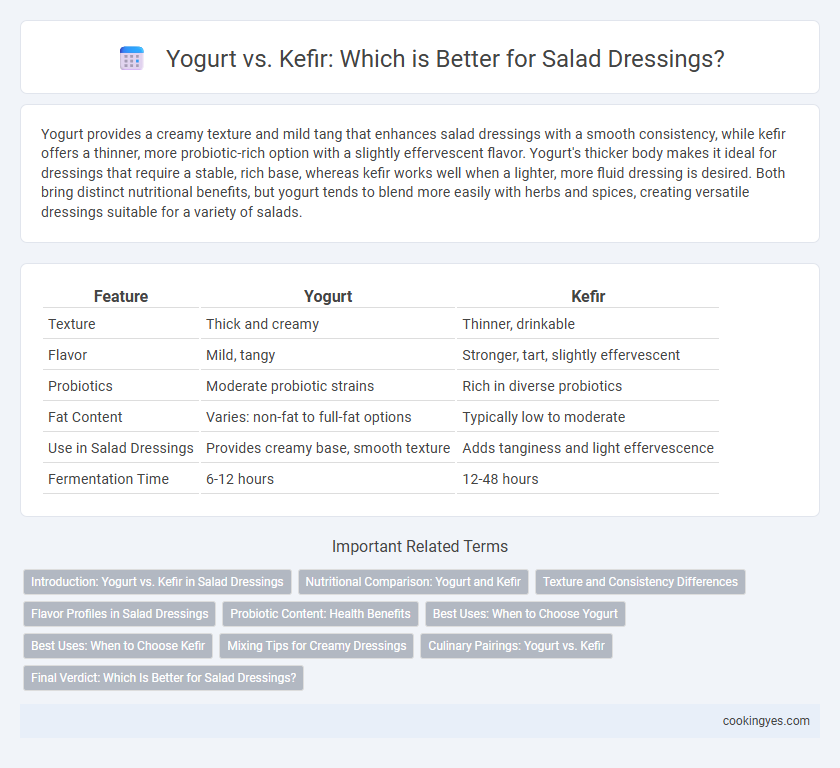Yogurt provides a creamy texture and mild tang that enhances salad dressings with a smooth consistency, while kefir offers a thinner, more probiotic-rich option with a slightly effervescent flavor. Yogurt's thicker body makes it ideal for dressings that require a stable, rich base, whereas kefir works well when a lighter, more fluid dressing is desired. Both bring distinct nutritional benefits, but yogurt tends to blend more easily with herbs and spices, creating versatile dressings suitable for a variety of salads.
Table of Comparison
| Feature | Yogurt | Kefir |
|---|---|---|
| Texture | Thick and creamy | Thinner, drinkable |
| Flavor | Mild, tangy | Stronger, tart, slightly effervescent |
| Probiotics | Moderate probiotic strains | Rich in diverse probiotics |
| Fat Content | Varies: non-fat to full-fat options | Typically low to moderate |
| Use in Salad Dressings | Provides creamy base, smooth texture | Adds tanginess and light effervescence |
| Fermentation Time | 6-12 hours | 12-48 hours |
Introduction: Yogurt vs. Kefir in Salad Dressings
Yogurt offers a creamy texture and mild tang that enhances salad dressings with a smooth consistency, while kefir provides a thinner, more probiotic-rich alternative with a slightly effervescent flavor. Both dairy products contribute beneficial cultures, but kefir's unique fermentation process introduces a more complex taste profile and additional enzymes. Choosing between yogurt and kefir in salad dressings depends on desired texture and flavor intensity, with yogurt favoring creaminess and kefir adding a zesty, probiotic boost.
Nutritional Comparison: Yogurt and Kefir
Yogurt and kefir both offer rich sources of probiotics, calcium, and protein, essential for gut health and bone strength, yet kefir contains a more diverse range of beneficial bacteria and yeast strains, enhancing digestion more effectively. While yogurt typically provides a thicker texture ideal for creamy salad dressings, kefir's thinner consistency makes it suitable for lighter, tangier dressings with a slightly effervescent profile. Nutritionally, kefir often has slightly lower lactose content due to fermentation, making it more suitable for lactose-sensitive individuals seeking a probiotic boost in salad dressings.
Texture and Consistency Differences
Yogurt offers a thick and creamy texture ideal for rich, smooth salad dressings that cling well to greens, while kefir's thinner, more liquid consistency creates lighter, pourable dressings with a slightly effervescent quality. The probiotic cultures in kefir contribute to a tangier flavor and a slightly fizzy mouthfeel, contrasting with yogurt's milder taste and dense body. Choosing between yogurt and kefir for salad dressings depends on desired texture and consistency, with yogurt providing creaminess and kefir adding a refreshing, thinner finish.
Flavor Profiles in Salad Dressings
Yogurt offers a creamy, mild tanginess that blends seamlessly into salad dressings, enhancing flavors without overpowering other ingredients. Kefir features a more pronounced, slightly effervescent tartness with a complex probiotic profile, adding a unique zing and depth to dressings. Both provide a rich texture, but kefir's distinct flavor can elevate dressings with a sharper, more vibrant character.
Probiotic Content: Health Benefits
Yogurt and kefir both contain probiotics that support digestive health, but kefir typically boasts a higher diversity and concentration of probiotic strains, including Lactobacillus and Bifidobacterium species, which enhance gut flora more effectively. The elevated probiotic content in kefir can improve immune function, reduce inflammation, and promote nutrient absorption better than yogurt. Incorporating kefir into salad dressings delivers these enhanced health benefits while maintaining creaminess and flavor.
Best Uses: When to Choose Yogurt
Yogurt is ideal for creamy salad dressings that require a thicker texture and mild tanginess, complementing fresh vegetables and herbs without overpowering other flavors. It works best in dressings that benefit from a smooth consistency and subtle acidity, such as ranch or cucumber-dill dressings. Choose yogurt when you want a rich, dairy-based base that blends easily with oils and spices for a balanced, creamy dressing.
Best Uses: When to Choose Kefir
Kefir's thinner consistency and tangy flavor make it ideal for light, creamy salad dressings that require easy mixing and a probiotic boost. Its natural effervescence balances well with sharp vinegars and fresh herbs in vinaigrettes or drizzle-style dressings. Choose kefir when you want a fermented dairy option that enhances digestion and adds a subtle zing without overpowering salad ingredients.
Mixing Tips for Creamy Dressings
For creamy salad dressings, yogurt offers a thicker consistency that blends smoothly with herbs and spices, while kefir provides a tangier flavor and thinner texture ideal for lighter dressings. When mixing, whisk yogurt thoroughly to eliminate lumps and achieve a velvety base; for kefir, combine it slowly with oil to ensure proper emulsification without separation. Using full-fat varieties enhances creaminess, and incorporating mustard or honey helps stabilize the dressing and balance acidity.
Culinary Pairings: Yogurt vs. Kefir
Yogurt's creamy texture and mild tanginess create a rich base for salad dressings, pairing well with herbs like dill, mint, and parsley, enhancing Mediterranean and Middle Eastern flavors. Kefir, with its effervescent tang and thinner consistency, offers a lighter dressing option that complements sharp ingredients like garlic, lemon, and mustard, making it ideal for bright, zesty dressings. Both dairy cultures provide probiotics, but yogurt's thicker consistency allows emulsifying oil and vinegar more effectively, while kefir adds a unique fermented depth to dressings.
Final Verdict: Which Is Better for Salad Dressings?
Yogurt offers a creamier texture and milder flavor, making it ideal for smooth, rich salad dressings, while kefir provides a tangier taste and thinner consistency that works well in lighter, more acidic dressings. The probiotic content in both enhances digestion, but yogurt's thicker profile helps emulsify dressings better. For versatility and texture in salad dressings, yogurt is generally the preferred choice.
Yogurt vs Kefir for Salad Dressings Infographic

 cookingyes.com
cookingyes.com